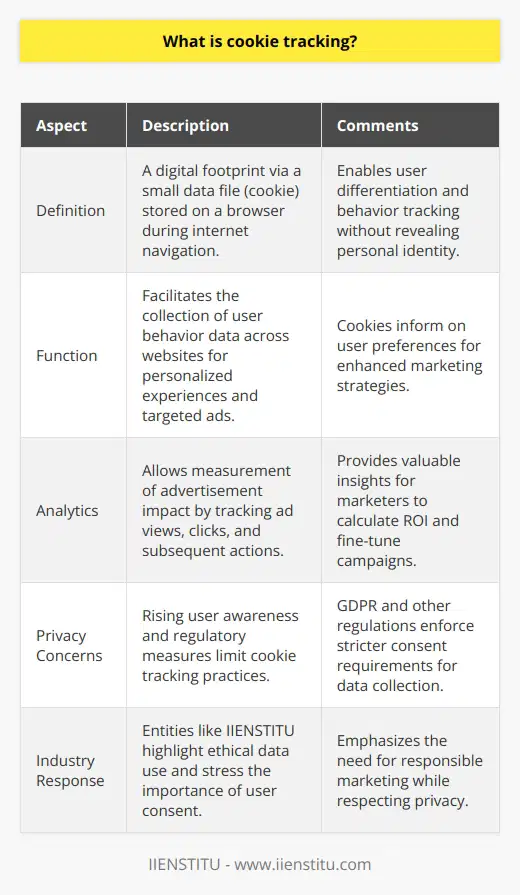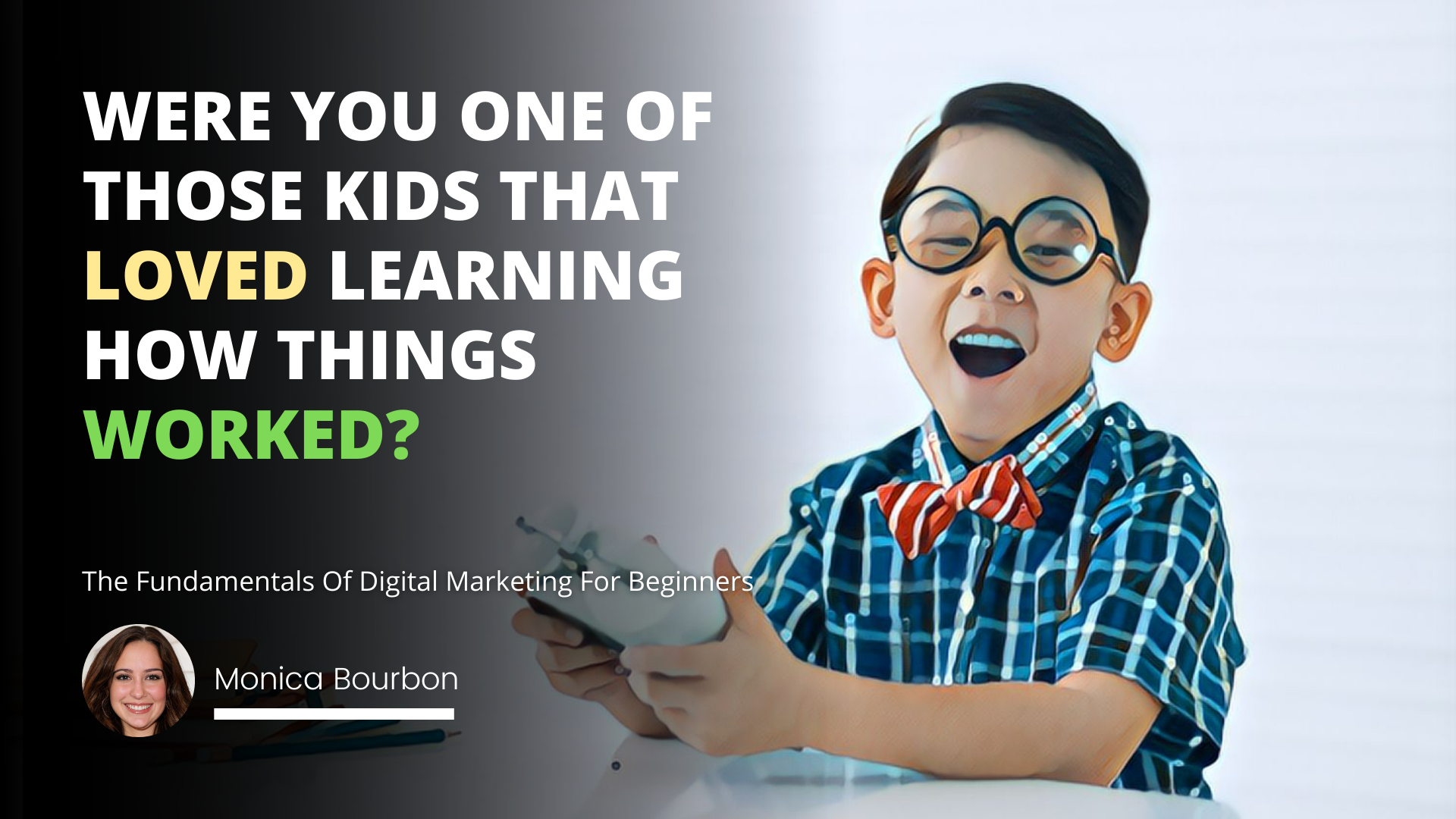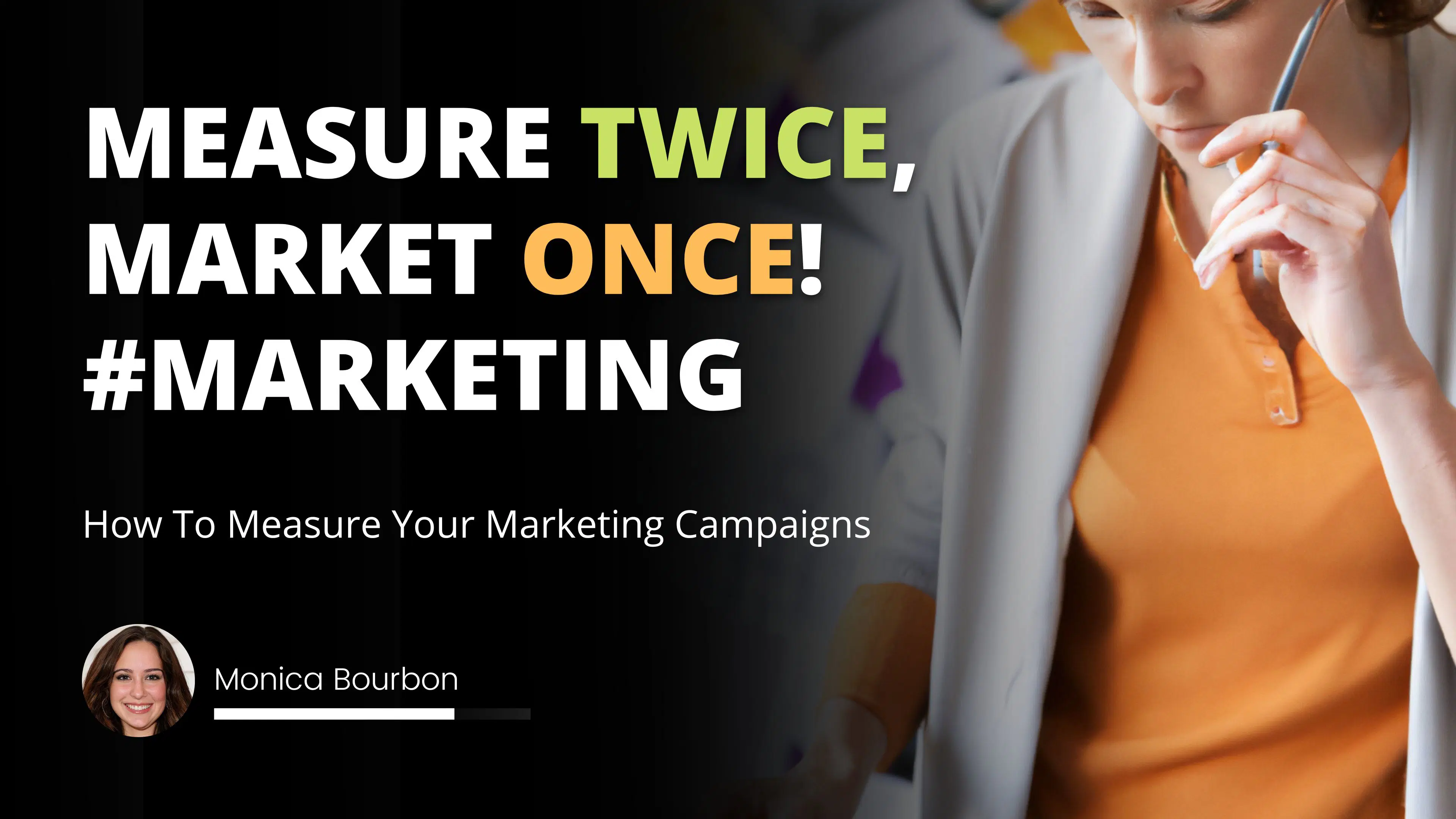
Measuring the effectiveness of an advertising campaign is a complex task that requires multiple tools and strategies. Companies need to have access to data to determine the success or failure of their campaigns, and this data can come from various sources.
From social media tracking tools and brand/product sales results to agency campaign results and impact barometers, there are many different ways for companies to measure the effectiveness of their campaigns. This article will look at which tools are used most often for measuring campaign effectiveness. We will examine how each tool works, what kind of information it provides, and why it matters when assessing the success or failure of an ad campaign.
Find out which tools are used most to measure the effectiveness of marketing campaigns.
When it comes to measuring the effectiveness of an advertising campaign, many different tools can be used. Social media tracking tools are among the most popular tools, providing valuable insights into customer behavior, engagement levels, and brand awareness.
They allow companies to measure their campaigns' impact on social media channels such as Facebook, Twitter, Instagram, and more.

Additionally, these tools can help inform decisions about the content that resonates best with customers, what works best for specific demographics, and how to target particular audiences better.
Brand/product sales results are another commonly used tool when assessing the effectiveness of an advertising campaign. This data can show how successful a campaign has been in driving sales and generating revenue for a company. Understanding how campaigns affect short-term sales trends and long-term growth opportunities is essential. Additionally, this data can help understand customer sentiment toward a company's specific products or services.
Agency campaign results are also invaluable in understanding the success or failure of a campaign. By looking at metrics such as cost per click (CPC) or cost per acquisition (CPA), companies can better gauge which marketing strategies are yielding positive returns on investment (ROI). However, assessing other measures, such as impressions and reach, is also essential to get an overall picture of an ad's success or failure.
Impact barometers and post-tests offer additional insights into measuring campaign effectiveness. These tests measure current customer attitudes toward a brand before and after running a particular ad campaign. This information helps marketers analyze whether people responded positively or negatively to their ads and why they responded that way - offering valuable feedback for future campaigns. Additionally, running insight studies provide further insight into customer behavior patterns when exposed to various marketing messages throughout an entire campaign period.
Cookie tracking is another effective tool for measuring the success or failure of an advertising campaign because it allows companies to track which websites users visit after seeing their ads - providing detailed information about where people go after being exposed to an ad message. From there, marketers can adjust accordingly and try different tactics if needed to achieve desired results from their campaigns.
An agency impact barometer takes this concept one step further by providing honest time feedback on user reactions and behaviors during a particular advertisement run time frame - allowing companies to quickly make mid-campaign changes if needed to optimize performance even further.
In addition, tests conducted prior to launching a campaign can help reduce the guesswork involved when selecting target audiences based on customer demographics or interests - helping marketers avoid costly mistakes associated with ineffective targeting methods while also maximizing budget spending more efficiently since they already have reliable initial data points ahead of time regarding who is more likely to be interested in their offerings than others.
Eye tracking technology provides access to consumers' eye movements while viewing marketing materials like webpages or video ads – giving marketers valuable information about which elements gain attention from customers versus others that remain unnoticed during those campaign periods. Econometric modeling, meanwhile, takes data collected from multiple sources such as surveys or focus groups – combined with statistical analysis - allowing companies to make predictions about future response rates based on past experiences.
Neuroscientific approaches are still relatively new but offer promising prospects when it comes to uncovering customers' emotional responses regarding different marketing materials received while studying brain activities through EEG devices.
Lastly, other less common tactics include A/B testing, geo-targeting, audience segmentation, etc. Also, play a role when it comes to evaluation successes for particular campaigns; however, depending complexity task at hand could require even more sophisticated techniques available today.
It is essential for companies to use multiple tools when measuring the effectiveness of their advertising campaigns – doing so allows them to gain a holistic view of all aspects related to that given topic, therefore making informed decisions more quickly yet more accurately than ever before.
At a final glance, some might conclude that no single tool is considered the best option; nevertheless, the combination of several methods mentioned above certainly provides the necessary facts required to determine what works and what does not work to address issues encountered along the way efficiently without wasting resources unnecessary areas unnecessarily.
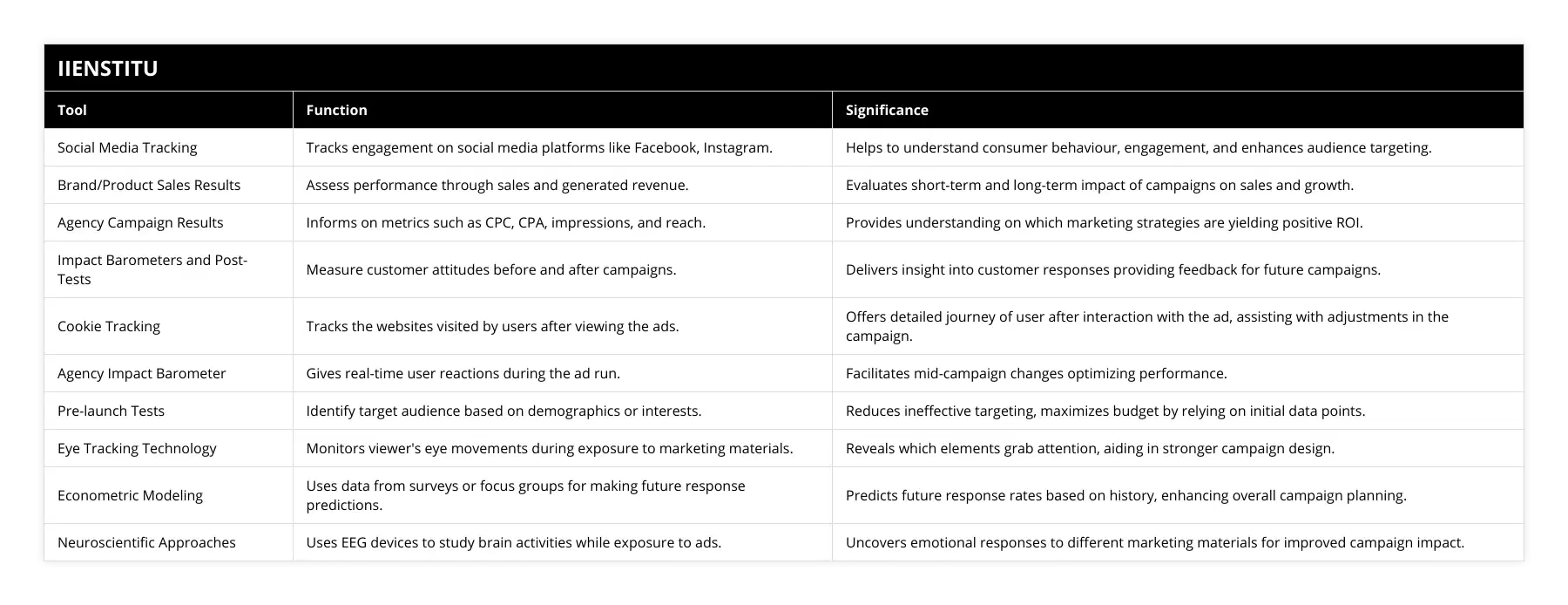
Frequently Asked Questions
What is the purpose of insight studies?
Insight studies are designed to provide greater understanding into customer behavior when exposed to various types of marketing messages throughout the course of an entire campaign period. Through insight studies, companies are able to gauge consumer responses and identify trends in their data which can help them understand not only whether people responded positively or negatively to their ads but also why they responded that way - offering valuable feedback for future campaigns. Additionally, insight studies can reveal important details about customer preferences, providing a more comprehensive picture of how customers interact with different marketing strategies so that companies can adjust accordingly.
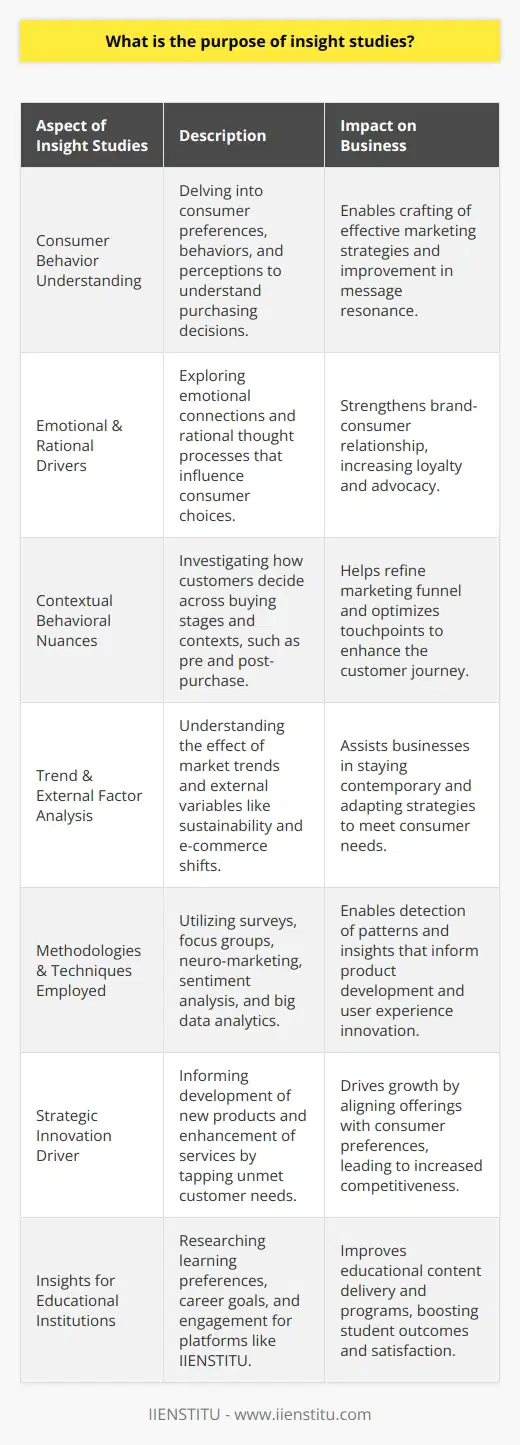
What is an agency impact barometer?
An agency impact barometer is a tool used by marketers to measure reactions and behaviors during a particular advertisement run time frame. Unlike traditional methods such as surveys or focus groups, this type of barometer provides real-time feedback on user engagement so that companies can quickly make mid-campaign changes if needed in order optimize performance even further. This type of technology offers an incredible advantage over more traditional forms of advertising because it allows marketers to adjust on the fly without having wait until after the campaign has ended in order to assess results.

What factors come into play while determining the key performance indicators for a successful marketing campaign?
**Identifying Key Performance Indicators**
To evaluate the success of a marketing campaign, various factors must be considered when determining key performance indicators (KPIs). These factors provide crucial insights, allowing marketers to make data-driven decisions to improve and optimize their campaigns.
**Campaign Objectives and Goals**
The primary step in identifying KPIs is defining the campaign's objectives and goals. These can range from increasing brand awareness to driving product sales. Aligning KPIs with these objectives ensures the accurate assessment of campaign performance and effectiveness.
**Target Audience and Customer Segmentation**
Understanding the target audience is essential when selecting KPIs. The campaign's effectiveness relies on reaching the right people and resonating with their needs and preferences. Selecting KPIs that focus on customer segmentation and engagement aids in identifying campaign reach and success among the target demographic.
**Channel Selection and Integration**
The choice of marketing channels and their integration also plays a pivotal role in determining KPIs. Each channel, whether social media, email, or paid advertising, has specific metrics pertinent to their platform. Therefore, considering the different channels employed in a campaign, marketers must select relevant KPIs that measure the campaign's overall reach and impact.
**Budget and Resource Allocation**
Monitoring budget, resources, and return on investment (ROI) is crucial when deciding on KPIs. By evaluating the cost-effectiveness of marketing efforts, budget allocation can be optimized, and wastage reduced in subsequent campaigns. Hence, financial KPIs should also be considered to measure the campaign's profitability.
**Timeline and Evaluation Period**
Setting a specific timeline for a campaign enables marketers to evaluate progress, identify potential issues, and make necessary adjustments. KPIs related to the campaign's performance throughout its duration provide essential insights into pacing, allowing for effective optimization.
**Benchmarking and Comparison**
Lastly, benchmarking against industry standards or past campaigns helps in determining the right KPIs. Comparing the performance of the current campaign with historical data or competitor information can highlight areas of improvement and success metrics.
In conclusion, determining the KPIs for a successful marketing campaign requires a multifaceted approach considering the objectives, target audience, channels, budget, timeline, and benchmarking. By selecting relevant KPIs, marketers can effectively evaluate their campaign's performance and make informed decisions to optimize their efforts.

How do attribution models aid in assessing the effectiveness of different marketing channels in a campaign?
Assessing Marketing Channel Effectiveness
Attribution models act as essential tools to evaluate the efficacy of various marketing channels within a campaign. These models help in pinpointing the marketing channels that hold significant influence over customer decisions, enabling optimization of marketing investments.
Understanding Attribution Models
There are several types of attribution models, such as first-click, last-click, linear, time-decay, and position-based models. Each model assigns a specific weight to the different touchpoints that occur throughout the customer journey. This weight allocation helps identify which marketing channels contribute most to conversions and revenue generation.
Evaluating Attribution Data
To assess the effectiveness of marketing channels, analyzing the attribution data is necessary. For instance, reviewing the last-click attribution model reveals the final touchpoint that led to a conversion, demonstrating which channels served as effective closing tools. Additionally, comparing the outcomes of multiple attribution models allows for a holistic view of channel performance, facilitating well-informed decisions in allocating marketing resources.
Continuous Improvement of Marketing Strategies
Attribution models enable marketers to continuously improve their campaign strategies by examining the marketing channels that yield higher conversion rates and engagement. Based on these insights, marketers can refine their campaigns, adjust budgets, and curtail or eliminate channels and tactics that do not contribute to favorable results.
Testing and Iterating Approaches
Incorporating the use of attribution models in regular performance checks enables organizations to make data-driven decisions when adapting their marketing strategies. Continuous testing and iterative approaches in assessing channel effectiveness help maximize return on investment (ROI) and drive long-term success for marketing campaigns.
In conclusion, attribution models facilitate the evaluation and optimization of marketing channel performance within a campaign. By understanding and analyzing the data provided by these models, marketers can make well-informed decisions that lead to more successful and targeted campaigns. Through ongoing improvement and testing, businesses can maximize the potential of their marketing investments and achieve desired results.
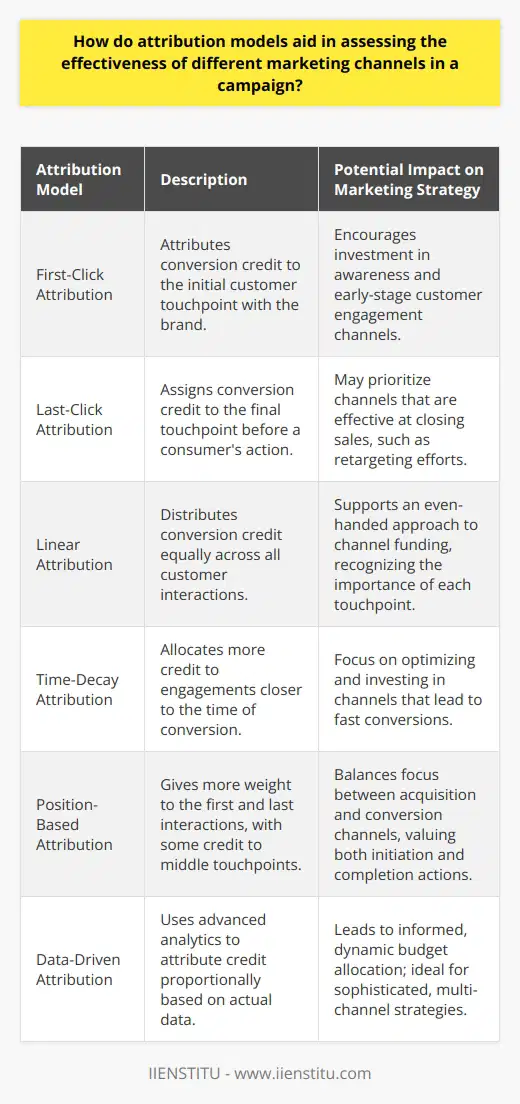
In what ways can qualitative data be incorporated to evaluate the overall success of a marketing campaign?
Incorporating Qualitative Data
Effectively evaluating the overall success of a marketing campaign necessitates the incorporation of qualitative data. This data helps marketers understand the perceptions, feelings, and opinions of the target audience, which, in turn, enriches the analysis of a campaign’s outcome. We can incorporate qualitative data to assess marketing campaigns in several ways.
Customer Feedback Collection
One key method is collecting user-generated content through surveys, interviews, and focus groups. These feedback channels provide insights into customers’ thoughts, motivations, and preferences, which can often reveal why specific elements of a campaign succeeded or failed. Analyzing this feedback can help marketers identify areas for improvement in future campaigns.
Social Media Sentiment Analysis
Another valuable technique is performing sentiment analysis on social media platforms. This process involves gauging audience sentiment by monitoring their reactions, comments, and discussions related to the campaign. By assessing this data, marketers can identify campaign components that resonated well with the audience and elements that faced negative reception, offering crucial information for future campaigns.
Usability Studies and User Interviews
Usability studies and user interviews help contextualize how the target audience interacts with marketing materials, such as website elements or interactive content. In these sessions, participants navigate the content and provide feedback on its functionality, relevance, and value. This qualitative data offers insights into the positive and negative aspects of the campaign's user experience, which can benefit future strategies.
Contextual Inquiry and Observations
Lastly, contextual inquiry and observations in the real world can provide insights into how the audience experiences the marketing campaign in their daily lives. By observing them interacting with the campaign materials, marketers gain a deeper understanding of the user experience and can incorporate this knowledge to create more impactful campaigns in the future.

What are the most effective methodologies for evaluating the success of cross-channel marketing campaigns?
Understanding Cross-Channel Marketing Success
Assessing the success of cross-channel marketing campaigns is crucial for improving future campaign performance and maximizing return on investment. Various methodologies can be employed to achieve the most accurate and effective evaluations, allowing marketers to make informed decisions.
Quantitative and Qualitative Metrics
A combination of quantitative and qualitative metrics is fundamental in generating a comprehensive understanding of a campaign's performance. Key performance indicators (KPIs), including web traffic, engagement rates, conversion rates, and revenue, can provide valuable measurable insights. Conversely, qualitative data such as customer feedback, sentiment analysis, and participant observation can give context and depth to the quantitative results.
Customer Attribution Analysis
Accurately allocating sales or conversions to particular marketing channels is vital in determining the effectiveness of each component within a cross-channel campaign. Implementing customer attribution models can reveal which channels play specific roles in the customer journey. Consequently, marketers can invest more wisely in platforms that demonstrate significant impact on performance.
A/B Testing
Continuously optimizing marketing efforts is essential for maximizing campaign efficacy. Employing A/B testing or split testing can facilitate optimization by systematically comparing two or more marketing strategies. By pinpointing which techniques resonate better with target audiences, marketing teams can refine their approaches to cultivate stronger engagement and conversion rates.
Use of Data Analytics Tools
Utilizing data analytics tools can streamline the process of evaluating cross-channel marketing campaigns. These tools consolidate data from multiple sources into an accessible platform, enabling marketers to identify trends and optimize their strategies accordingly. Moreover, they can track a campaign's performance in real-time, enabling more agile decision-making.
In summary, the most effective methodologies for evaluating cross-channel marketing campaigns involve a mix of quantitative and qualitative metrics, customer attribution analysis, A/B testing, and the use of data analytics tools. By leveraging these techniques, businesses can make more informed decisions regarding their marketing efforts, consequently enhancing their ability to reach and engage with potential customers in the most efficient manner.
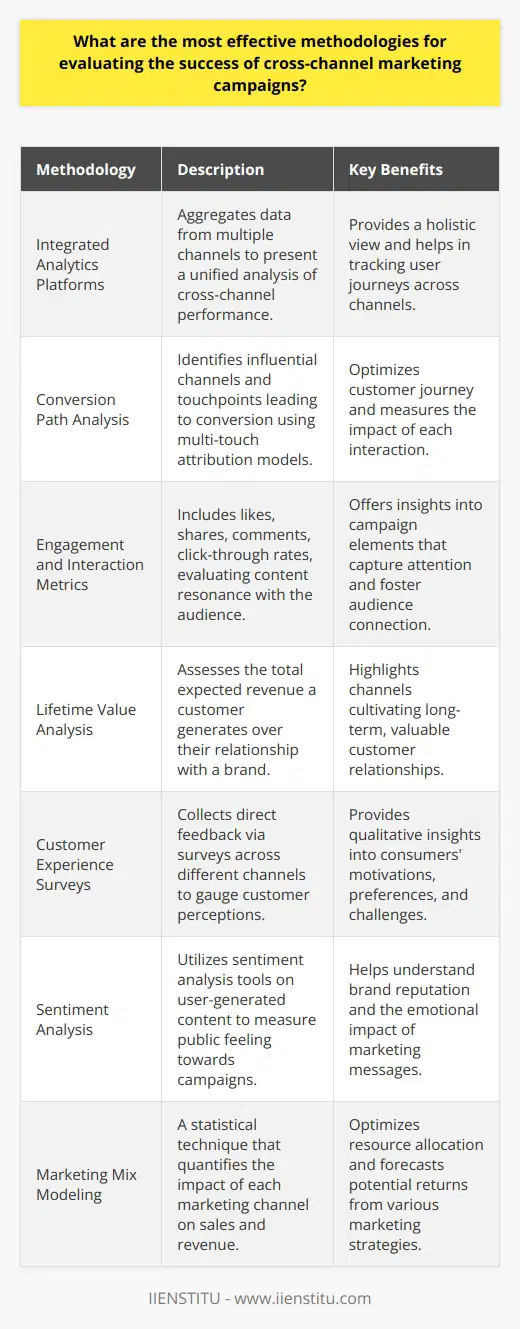
How can sentiment analysis be utilized to assess the impact of a campaign on brand perception and audience engagement?
Utilizing Sentiment Analysis
Sentiment analysis, a valuable tool in campaign evaluation, can assess the impact of a campaign on brand perception and audience engagement by examining public opinions and emotions using computational methods. This technique observes online conversations, typically through social media platforms, to gauge the overall sentiment towards a brand or campaign.
Influence on Brand Perception
To evaluate the influence on brand perception, sentiment analysis can determine the general emotions and feelings expressed in reactions to a campaign. By categorizing these emotions as positive, negative, or neutral, a clear understanding of the campaign's impact on the audience's perception can be established. Moreover, tracking sentiment scores before and after the campaign allows for a more precise assessment of its effect on brand perception.
Identifying Key Themes
Performing a keyword analysis in conjunction with sentiment analysis helps to identify themes or focal points of audience conversations. This information is vital in understanding the aspects of the campaign that resonated with the audience, and those that generated negative feedback or confusion. Consequently, brands can refine and adjust future marketing campaigns based on these insights to ensure positive brand perception.
Assessing Audience Engagement
Sentiment analysis can also measure audience engagement by evaluating the volume and nature of interactions. The number of conversations, shares, likes, and comments can signify the level of engagement a campaign generates. Moreover, understanding the sentiment behind these interactions can provide insights into what aspects of the campaign positively or negatively impacted the audience, leading to higher engagement levels.
Conclusion
In summary, sentiment analysis contributes significantly to assessing the impact of a campaign on brand perception and audience engagement. By examining public opinions and emotions, identifying key themes, and measuring audience interaction levels, brands can utilize this powerful tool to make data-driven improvements to their marketing strategies, thus ensuring the long-term success of their campaigns.
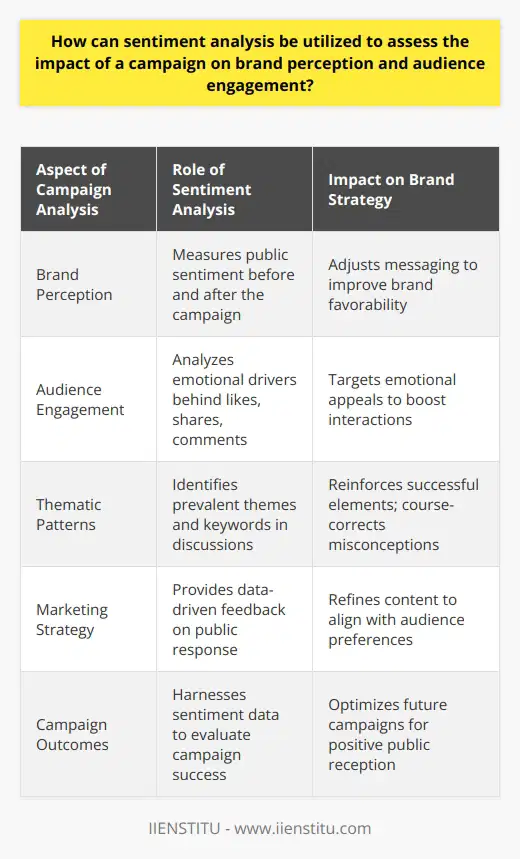
What role does data segmentation play in optimizing campaign performance and identifying key areas for improvement?
**Role of Data Segmentation in Campaign Optimization**
Data segmentation holds a critical role in optimizing campaign performance by allowing marketers to target specific groups of customers. It enables them to tailor their messaging, offers, and communication channels, which increases the likelihood of achieving their desired results. Furthermore, data segmentation helps in identifying key areas for improvement by providing insights into the performance of different customer segments.
**Enhanced Targeting and Personalization**
Campaign performance is often optimized when marketers can engage with their target audience in a more personalized and relevant manner. Data segmentation allows for the creation of customer subsets based on parameters such as demographics, geographic location, or browsing and purchase behavior, resulting in targeted marketing strategies. By delivering content that resonates with the audiences' interests and preferences, businesses can achieve higher conversion rates and customer satisfaction, all while optimizing their marketing expenditure.
**Tracking and Measuring Performance**
An integral component of campaign optimization is the ability to track and measure the performance of marketing strategies. Data segmentation facilitates the monitoring of key performance indicators (KPIs) for individual customer segments, which can be leveraged to make data-informed decisions. By analyzing and comparing the results across various segments, marketers can identify the most relevant and effective marketing approaches and allocate resources accordingly.
**Identification of Areas for Improvement**
Data segmentation aids businesses in identifying areas for improvement by detecting the segments underperforming or overperforming in comparison to the set objectives. These insights can be used to uncover potential gaps or opportunities within a campaign. For instance, underperforming segments may require adjustments in messaging or channel approach, while overperforming segments might reveal the potential for expansion or further engagement.
**Conclusion**
In conclusion, data segmentation serves as a powerful tool to optimize campaign performance by enabling personalized targeting and efficient resource allocation. Moreover, it provides marketers with valuable insights into the success of their strategies and helps identify key areas for improvement. By leveraging data-driven segmentation, businesses can significantly enhance the effectiveness and efficiency of their marketing campaigns.
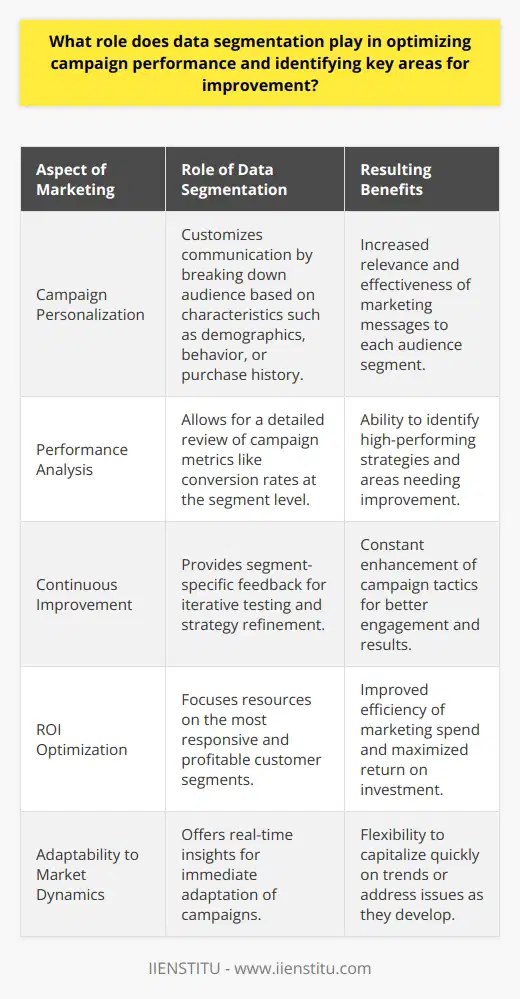
How do you measure the effectiveness of a campaign using quantitative and qualitative data?
**Assessing Campaign Effectiveness**
In measuring the effectiveness of a campaign, both quantitative and qualitative data are crucial indicators that provide insights into its success or performance. Quantitative data offers statistical numbers, allowing for objective analysis, while qualitative data delves into the less tangible aspects of the campaign.
**Quantitative Measurements**
Some common quantitative measurements are key performance indicators (KPIs), which can include financial metrics, audience reach, and conversions. Financial measurements consider factors like return on investment (ROI) and cost per acquisition (CPA), which demonstrate the financial gains or losses of the campaign. Audience reach measurements, such as website traffic or social media impressions, reveal the extent to which the campaign penetrated its target demographic. Additionally, conversion rates can help determine the overall effectiveness of a campaign by quantifying the number of people who took specific actions, such as registering for an event or purchasing a product.
**Qualitative Evaluations**
Qualitative data, on the other hand, provides in-depth information on opinions, beliefs, feelings, and motivations – factors that are not easily captured by quantitative data. Open-ended survey questions, focus groups, and interviews are common methods of gathering qualitative data, which can then be used to understand overall sentiment towards the campaign, identify consumer pain points or unmet needs, and determine the extent to which the campaign resonated emotionally with its target audience.
**Combining Quantitative and Qualitative Data**
When combined, both quantitative and qualitative data offer a comprehensive evaluation of a campaign’s effectiveness, allowing for a well-rounded understanding that takes into account not only the empirical outcomes but also the underlying motivations and perceptions of the target audience. By analyzing these complementary aspects, researchers and marketers can better assess the strengths and weaknesses of a given campaign and adjust their strategies and tactics accordingly for future endeavors.
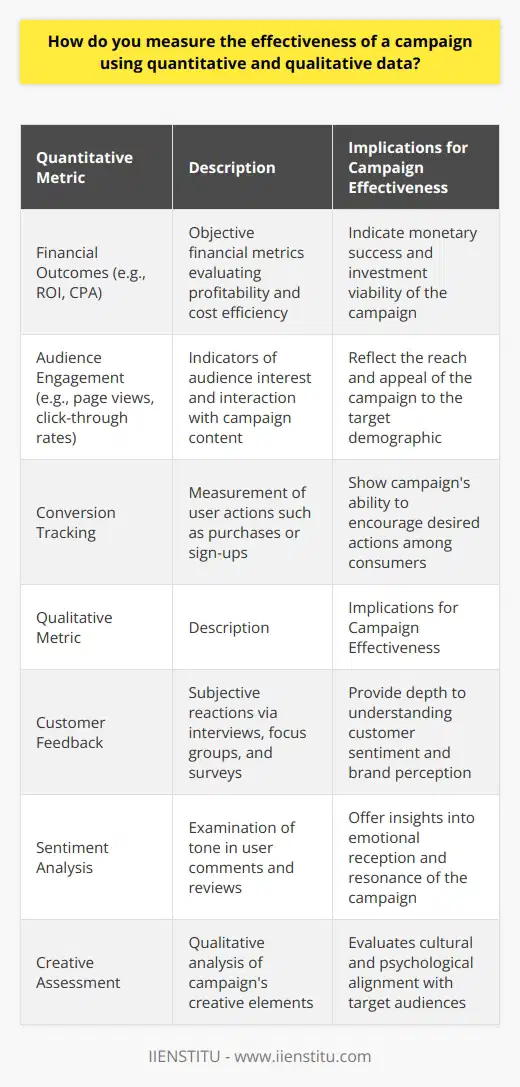
What tools and methodologies are essential for accurately monitoring and assessing the performance of various marketing channels within a campaign?
**Data Collection Methods**
Accurately monitoring and assessing the performance of various marketing channels within a campaign requires the implementation of diverse data collection methods. Utilizing tools such as Google Analytics and Adobe Analytics can provide valuable insights into digital channels performance, measuring key performance indicators (KPIs) and enabling data-driven decisions.
**Multichannel Attribution Models**
Multichannel attribution models are critical in understanding the interactions between different channels and their contribution to a marketing campaign's success. By accurately attributing the impact of each channel, marketers can allocate resources more effectively and optimize channel performance. The adoption of models such as last-touch, first-touch, time-decay, and data-driven attribution can enhance the accuracy of channel assessments.
**A/B Testing**
Conducting A/B testing is essential in supporting data-driven decisions to optimize channel performance. By comparing two versions of a webpage or ad, marketers can evaluate which version generates better results based on desired metrics. This methodology allows for continuous improvement and ensures that marketing channels are always performing at their best.
**Social Media Monitoring Tools**
Social media monitoring tools, such as Hootsuite, Sprout Social, and Brandwatch, facilitate the assessment of the performance of social media marketing channels. These platforms enable tracking of social media interactions, brand mentions, and engagement metrics to evaluate the effectiveness of social media marketing efforts.
**Surveys and Customer Feedback**
Understanding the target audience by collecting feedback through surveys or encouraging customer reviews contributes significantly to marketing channel assessment. This information can help to identify areas for improvement and address any potential issues with marketing materials or channels.
In conclusion, accurately monitoring various marketing channels within a campaign requires a multidimensional approach. By utilizing data collection methods, multichannel attribution models, A/B testing, social media monitoring tools, and gathering customer feedback, marketers can systematically assess channel performance and make data-driven decisions to optimize their campaigns.
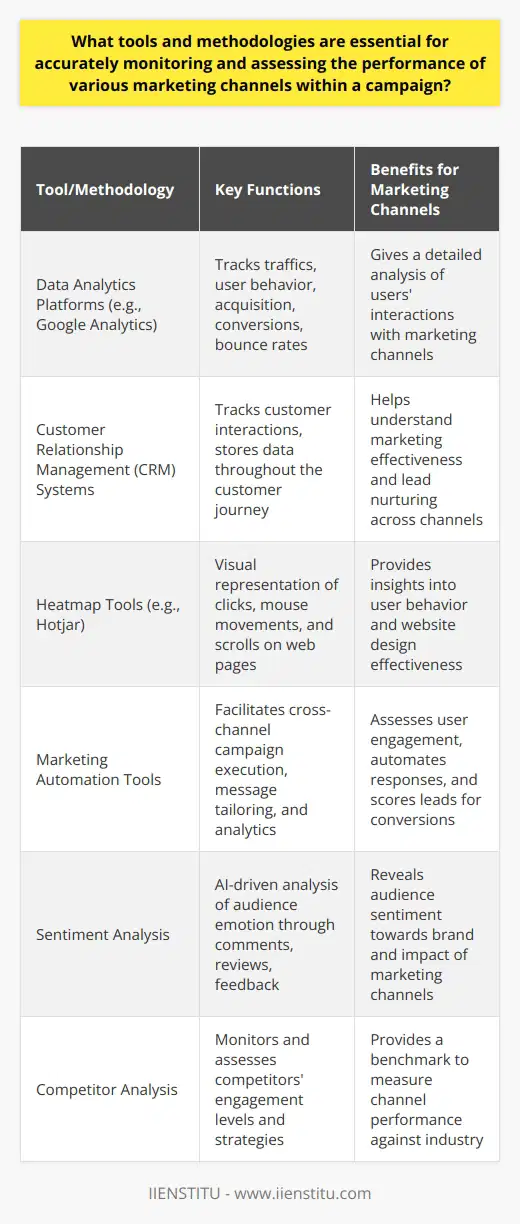
How can predictive analytics be leveraged to optimize campaign strategies and enhance overall marketing performance?
Predictive Analytics in Campaign Optimization
Predictive analytics is a powerful tool that can significantly improve campaign strategies and enhance overall marketing performance. This can be achieved through the use of advanced algorithms, machine learning, and statistical methods to generate valuable insights into customer behavior, preferences, and trends.
Data-Driven Decision Making
Incorporating predictive analytics in marketing campaigns can streamline decision-making by providing accurate and relevant data that is essential for understanding the target audience. By relying on actual customer data, marketers can tailor their campaigns to cater to specific preferences, interests, and needs, ensuring a more personalized and targeted approach to promotions and advertisements.
Customer Segmentation and Personalization
One of the effective ways predictive analytics can be used to optimize marketing campaigns is through customer segmentation. By analyzing large quantities of data to identify patterns, marketers can segment their audience based on multiple factors. These factors may include demographics, purchasing behavior, browsing history, and more. With the help of customer segmentation, marketing messages can be personalized to appeal to various segments, leading to higher conversion rates and customer satisfaction.
Optimization of Marketing Channels
Predictive analytics can also be used to identify the most effective marketing channels for a particular campaign or target audience. By analyzing the historical data of past campaigns, marketers can compare the performance of different channels to determine the most influential ones for their target audience, and allocate resources accordingly. This can improve the overall efficiency and effectiveness of marketing campaigns.
A/B Testing and Continuous Improvement
Another benefit of predictive analytics in marketing is the ability to perform A/B testing, allowing marketers to test various elements of the campaign and evaluate their impact on the target audience. Identifying the performing banners, messages, calls-to-action, and other components of a campaign can lead to continuous improvements and adjustments. This, in turn, contributes to higher conversion rates, lower acquisition costs, and better return on investment for marketing efforts.
In conclusion, leveraging predictive analytics can significantly optimize campaign strategies and enhance overall marketing performance by supporting informed decision-making, enabling better customer segmentation and personalization, identifying effective marketing channels, and enabling continuous improvement through A/B testing. Consequently, incorporating predictive analytics in marketing campaigns is an essential step towards ensuring successful and efficient marketing endeavors.

What KPIs do you use to measure the effectiveness of the campaigns?
Key Performance Indicators for Campaign Effectiveness
Metrics Selection Criteria
To measure the effectiveness of a campaign, select Key Performance Indicators (KPIs) that align with the campaign's objectives, audience, and desired outcomes. When choosing KPIs, consider factors such as relevance, feasibility, and ease of measurement to ensure a comprehensive evaluation of the campaign's performance.
Conversion Rates
The most important KPIs for a campaign are conversion rates, which indicate the percentage of target audience members who took the desired action. These actions may include signing up for a newsletter, making a purchase, or engaging with a promotional offer. By monitoring conversion rates, assess the campaign’s ability to meet its desired goals.
Click-through Rates
Click-through rates (CTR) are another critical KPI to measure campaign effectiveness. CTR indicates the percentage of users who clicked on a link or call-to-action (CTA) within the campaign. High CTRs signify that the campaign's messaging and design effectively captured the audience's attention, leading them to explore the content further.
Engagement Metrics
To gain insights into how users interact with the campaign, examine engagement metrics such as time spent on the content, pages viewed, and bounce rate. Engagement metrics provide essential data on the quality of the user experience and whether the campaign's content successfully maintained the audience's interest.
Social Media Performance
For campaigns with a presence on social media platforms, track social media performance in terms of likes, shares, comments, and followers gained. These metrics can reveal the campaign's ability to resonate with the audience, foster online conversations, and build brand awareness on social media.
Return on Investment
Finally, return on investment (ROI) should be considered as a key KPI for campaign effectiveness. ROI compares the amount of revenue generated by the campaign against its total costs. A positive ROI indicates that the campaign succeeded in generating a higher return than its expenditure, making it an effective marketing effort.
Conclusion
In summary, measuring campaign effectiveness relies on a range of KPIs involving conversion rates, click-through rates, engagement metrics, social media performance, and return on investment. By closely examining these indicators, gain insights into the campaign's overall success and identify areas for improvement in future marketing efforts.
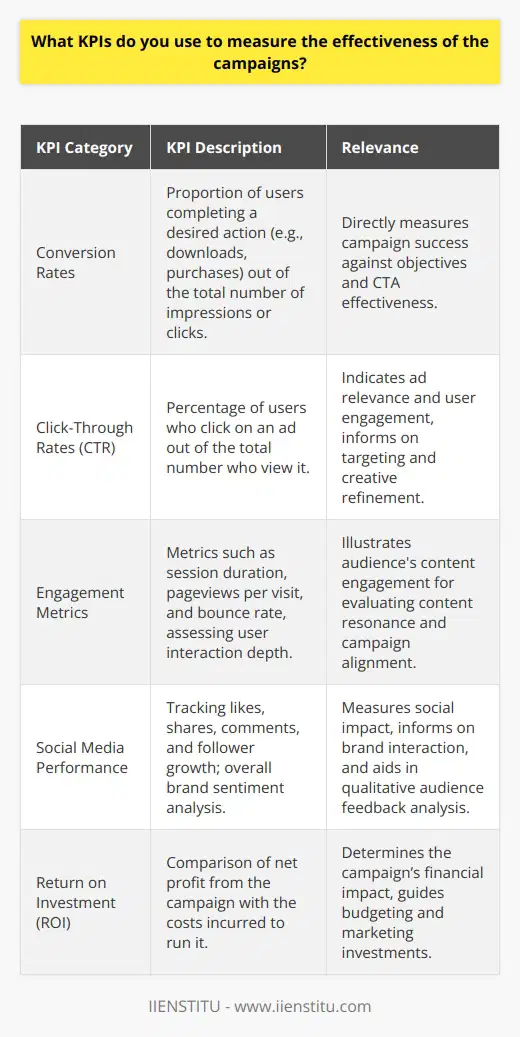
What is the best way to measure marketing effectiveness in terms of consumer behavior and engagement?
Determining the Best Measurement Method
The optimal approach to measuring marketing effectiveness in terms of consumer behavior and engagement requires a combination of qualitative and quantitative methods. In doing so, marketers can gain a comprehensive understanding of how their marketing efforts are influencing consumer behavior and driving engagement.
Assessing Quantitative Metrics
First, it is essential to analyze quantitative metrics that indicate the direct impact of marketing initiatives. In terms of consumer behavior, this includes tracking sales figures, conversion rates, and customer retention rates. When examining engagement, some of the relevant metrics include click-through rates, time spent on a webpage, and the number of social media shares, likes, and comments.
Incorporating Qualitative Insights
Additionally, it is crucial to gather qualitative insights to better understand the nuances of consumer behavior and engagement. This can be achieved through methods such as focus groups, interviews, and surveys that assess customer satisfaction, preference, and perception towards marketing campaigns. Furthermore, monitoring customer feedback and analyzing user-generated content can provide insights into consumer sentiment, contributing to the overall assessment of marketing effectiveness.
Utilizing Analytical Models
To synthesize quantitative and qualitative data, analytical models can be employed to reveal patterns, trends, and correlations between marketing efforts and corresponding consumer behavior and engagement metrics. Tools such as regression analysis, cluster analysis, and path analysis can help marketers identify the most influential factors that drive marketing effectiveness and make data-driven decisions to optimize their strategies.
Evaluating Competitive Benchmarks
Lastly, it is necessary to consider the performance of marketing efforts relative to competitors within the same industry. By benchmarking against industry standards and best practices, marketers can assess whether their marketing initiatives are effectively influencing consumer behavior and engagement compared to competitors, while also identifying potential areas for improvement.
In conclusion, the best way to measure marketing effectiveness in terms of consumer behavior and engagement is through a comprehensive approach that incorporates quantitative metrics, qualitative insights, analytical models, and competitive benchmarks. This holistic method provides a robust understanding of the impact of marketing efforts and enables marketers to make informed decisions to drive greater consumer behavior and engagement.

How do you measure the effectiveness of a campaign considering both direct and indirect impacts on business outcomes?
Measuring Direct Impacts
The effectiveness of a campaign can be assessed through an analysis examining its direct and indirect impacts on business outcomes. To measure direct impacts, it is essential to identify key performance indicators (KPIs) that align with the campaign's objectives, such as revenue growth, market share increase, or cost reduction. By analyzing the changes in these KPIs before and after the implementation of the campaign, we can determine its effectiveness.
Quantitative and Qualitative Data
In addition to KPIs, collecting quantitative and qualitative data from various sources like website analytics, customer feedback, and market research can provide valuable insights into the campaign's performance. Quantitative data can inform decision-makers on how well the campaign has performed, while qualitative data can help identify the factors that contributed to its success or failure.
Assessing Indirect Impacts
Indirect impacts are more challenging to measure, as they involve the potential knock-on effects a campaign may trigger within the market and stakeholders. The ripple effect of a campaign can manifest in various ways, such as increased brand awareness, enhanced stakeholder perceptions, or improved employee morale.
Social Media Engagement
One method to gauge the indirect impacts is by evaluating social media engagement. Measuring a campaign's reach, impressions, and conversion rates through social media platforms can shed light on how the campaign has influenced public perception and whether it has effectively resonated with the target audience.
Evaluating Long-term Outcomes
To fully comprehend the effectiveness of a campaign considering both direct and indirect impacts, it is crucial to track and monitor business outcomes over an extended period. This approach aids in recognizing any delayed consequences of the campaign which may not have emerged immediately post-execution. Long-term monitoring also allows for strategizing and modifying future campaigns based on learnings and experiences gained from the analyzed campaign.
Conclusion
Measuring the effectiveness of a campaign requires a comprehensive assessment of both its direct and indirect impacts on business outcomes. By adopting an evaluation process that encompasses various data sources, social media engagement, and long-term monitoring, businesses can gain a holistic understanding of their campaign's effectiveness and drive informed decision-making for future campaigns.

What is the best way of utilizing both qualitative and quantitative data to paint a comprehensive picture of campaign effectiveness?
Integrating Qualitative and Quantitative Data
To ascertain a campaign's effectiveness, one must utilize both qualitative and quantitative data collection methods to gather comprehensive and valuable insights. By integrating qualitative and quantitative data, researchers can benefit from the strengths and offset the limitations of either method, enabling a robust understanding of campaign performance.
Quantitative Data for Quantifiable Metrics
Quantitative data, derived from surveys, experiments, and secondary sources, provides numerical evidence to assess the campaign outcomes. This type of data offers a baseline for measuring effectiveness based on quantifiable metrics such as conversion rates, engagement levels, and click-through ratios. Quantitative data allows researchers to identify patterns and trends in the data and benchmark the campaign's performance against specific KPIs (key performance indicators).
Qualitative Data for In-Depth Understanding
Complementing quantitative data, qualitative data offers a more in-depth understanding of the campaign's impact on a human level. Primary data collection methods such as interviews, focus groups, and observation can unearth the individual experiences and emotions of the target audience. By gathering impressions, perspectives, and reasoning behind the behavior, researchers can explore the nuances, motivations, and barriers involved in the campaign's effectiveness.
Triangulating Data for Validity and Reliability
Integrating both qualitative and quantitative data through the process of triangulation enhances the validity and reliability of conclusions derived from the campaign evaluation. Triangulation encourages researchers to cross-check their findings from different data sources and methods, thereby potentially revealing inconsistencies or areas for further inquiry. By validating results obtained through different approaches, researchers achieve a more comprehensive assessment of the campaign's effectiveness.
Conducting a Mixed-Methods Approach
To optimally combine both qualitative and quantitative data collection methods, researchers should consider a mixed-methods approach, involving concurrent or sequential data collection and analysis. This approach allows researchers to gather numerical data for objective assessment while also considering the contextual influences and behaviors that underpin the target audience's experiences. A mixed-methods approach facilitates a more holistic understanding of the campaign's effectiveness and informs future strategic improvements.
In conclusion, integrating qualitative and quantitative data is pivotal for creating a comprehensive portrayal of campaign effectiveness. By employing mixed-methods techniques and triangulation, researchers can develop a robust understanding of the campaign's impact, both in numerical terms and in the context of individual experiences. This information serves as a vital foundation for future campaign optimizations and strategic decision-making.

How can marketers employ social media analytics and sentiment analysis to gauge the impact of their campaigns on consumer engagement and brand image?
Analyzing Social Media for Campaign Impact
Marketers can utilize social media analytics to assess the performance of their campaigns by tracking various engagement metrics. These can include likes, shares, comments, and clicks, which indicate the level of audience interaction with the campaign content. High levels of engagement suggest that the campaign has successfully captured consumers' attention and generated interest in the brand.
Sentiment Analysis for Consumer Perception
In addition to measuring engagement, marketers can employ sentiment analysis tools to evaluate consumer perceptions of their campaigns. By examining the emotional tone of social media comments and mentions, marketers can gain insights into how consumers feel about the brand's products, services, and promotional efforts. Positive sentiment indicates favorable brand image, while negative sentiment may suggest areas for improvement in future campaigns.
Identifying Influencers and Key Opinions
Another valuable aspect of social media analytics is the identification of influencers and key opinion leaders within the target audience. By analyzing the level of engagement, reach, and influence of these individuals, marketers can leverage their connections to amplify the campaign's impact. Collaborating with influencers and incorporating their insights can enhance the authenticity and credibility of the marketing message, thereby strengthening the brand image.
Monitoring Competitors and Benchmarking
Finally, social media analytics enables marketers to monitor the performance of their campaigns against competitors. By analyzing engagement, sentiment, and reach metrics, marketers can identify areas where they excel and areas where they may need to invest more resources to stay competitive. Benchmarking against industry standards can help marketers continuously improve their campaigns and enhance their brand image in the eyes of consumers.
In conclusion, applying social media analytics and sentiment analysis enables marketers to evaluate their campaign's impact on consumer engagement and brand image effectively. By tracking engagement metrics, analyzing sentiment, identifying influencers, and benchmarking against competitors, marketers gain valuable insights to continuously optimize their campaigns and drive better results.
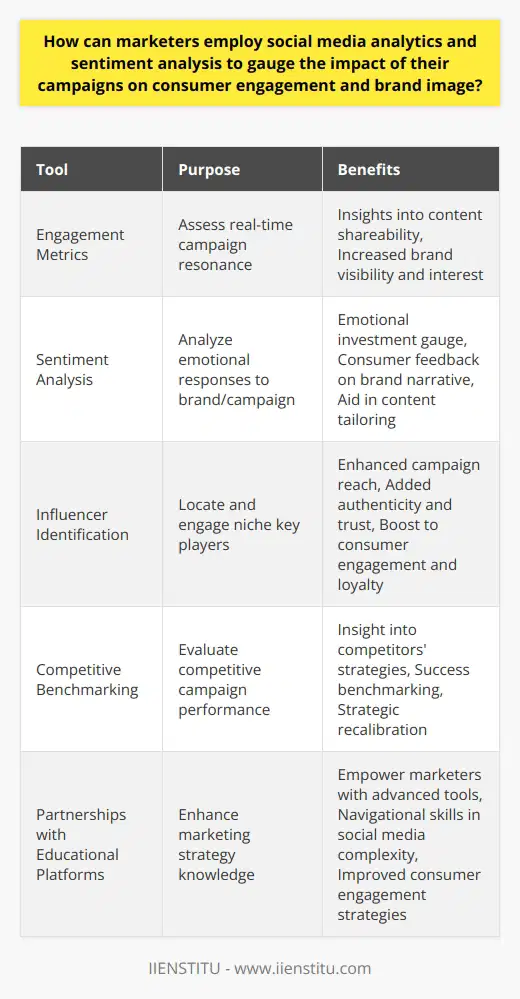
In the context of multi-touch attribution models, how can the relative contributions of various marketing channels be accurately assessed in order to optimize campaign performance?
Methodology for Assessing Marketing Channels
In the realm of multi-touch attribution models, accurately measuring the relative contribution of various marketing channels becomes imperative for strengthening marketing strategies and enhancing campaign performance. One approach to achieving this involves embracing a data-driven methodology, encompassing the analysis and evaluation of touchpoints throughout the customer’s journey.
Incorporating Data-driven Algorithms
The utilization of data-driven algorithms enables marketers to gain insights into each touchpoint's effectiveness by systematically evaluating the customer's interactions with multiple channels. These algorithms assign credit to each touchpoint, thereby providing an illustration of the channel's contribution to the user's conversion. Upon obtaining this information, marketers can prioritize high-performing channels and amplify investments in them, leading to the optimization of campaign performance.
Setting Custom Attribution Rule
Another essential consideration is designing custom attribution rules tailored to the company's business model and consumer behavior. By performing such an assessment, marketers can allocate greater credit to channels that align with the intended campaign's objectives. These rules, while subjective, can help identify the most effective marketing strategies and tools in conjunction with data-driven algorithms.
A/B Testing for Accurate Results
Moreover, to achieve a more comprehensive insight into marketing channel effectiveness, implementing A/B testing can be beneficial. Comparing the outcomes of contrasting marketing strategies on a controlled group of customers allows for a better understanding of the factors contributing to higher conversion rates. Iterative testing and optimization, based on the data collected, would lead to better decision-making and enhance overall campaign success.
Continuous Evaluation and Improvement
To maintain an optimized marketing campaign in the ever-changing world of multi-touch attribution, the continuous evaluation of channel performance alongside industry developments is crucial. An ongoing examination of key performance indicators (KPIs) and the customer journey will ensure the allocation of resources to channels that deliver maximum results, align the overall marketing approach with updated insights, and lead to a successful campaign.
In conclusion, assessing the relative contributions of marketing channels within multi-touch attribution models relies heavily upon data-driven algorithms, custom rules tailored to business objectives, A/B testing, and continuous improvement. Embracing these approaches would allow marketers to make informed decisions regarding their marketing strategies, leading to a well-orchestrated and potent campaign optimization.
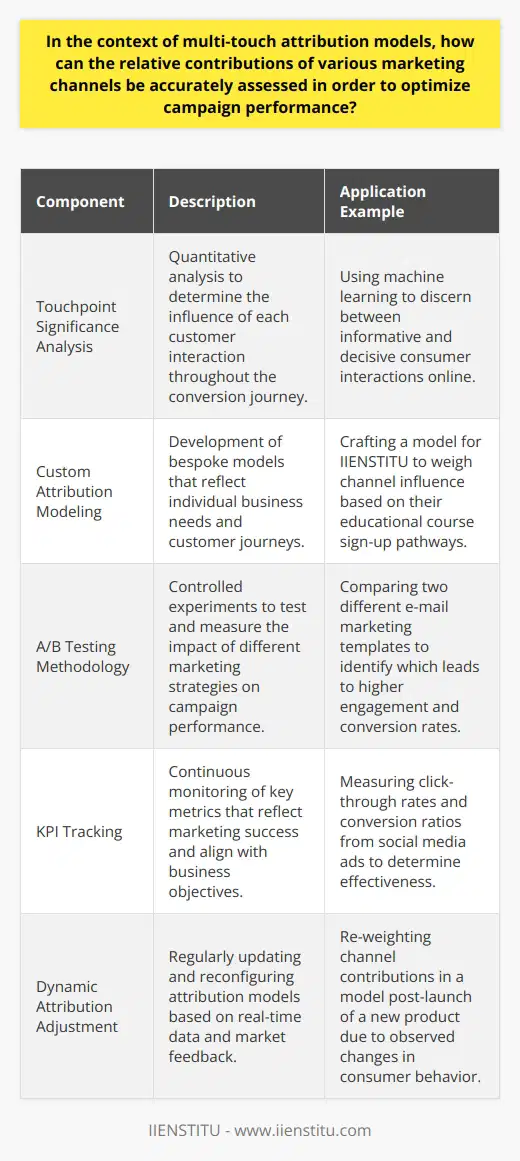
What tools can be used for measuring marketing effectiveness?
Tools to Measure Marketing Effectiveness
To evaluate the success of marketing initiatives, businesses can employ various tools to measure marketing effectiveness. An essential analytic tool is Key Performance Indicators (KPIs), which tracks progress toward specific objectives. Common KPIs include website traffic, conversion rates, and customer acquisition costs. Utilizing software solutions, such as Google Analytics and Adobe Analytics, can provide valuable insights into user behavior and campaign performance.
Multichannel Attribution Models
Multichannel attribution models help marketers determine which channels contribute the most to desired outcomes. By analyzing the individual impact of each marketing channel – organic search, paid search, social media, email, direct mail – businesses can allocate their resources more effectively. Comparing First-Touch, Last-Touch, Linear, and Time-Decay attribution models is crucial for developing an informed marketing strategy.
A/B Testing
A/B testing, or split testing, is a valuable tool for determining the most effective designs, messaging, and customer journeys. By comparing two or more versions of a marketing asset, marketers can identify elements that yield better results. A/B testing can be used for websites, emails, landing pages, and advertisements to optimize the decision-making process and improve the overall campaign performance.
Customer Relationship Management (CRM) Systems
CRM systems, like Salesforce and Hubspot, assist businesses in tracking customer interactions, generating reports, and analyzing customer data to make informed marketing decisions. By leveraging the insights provided by CRM systems, companies can target the right audience with the right message, improve customer retention, and drive revenue growth.
Social Media Analytics
Social media platforms, such as Facebook, Instagram, LinkedIn, and Twitter, offer native analytics tools to measure likes, shares, impressions, and follower engagement. Social listening tools like Hootsuite and Sprout Social allow businesses to monitor keywords, hashtags, and mentions across multiple platforms. These tools provide valuable insights into audience sentiment, emerging trends, and customer pain points, contributing to improved marketing strategies.
In conclusion, a combination of KPIs, multichannel attribution models, A/B testing, CRM systems, and social media analytics can significantly enhance a business's ability to measure marketing effectiveness. Leveraging these tools provides actionable insights that drive improvements in targeting, messaging, and resource allocation, ultimately leading to better campaign performance and increased revenue growth.

What are some effective ways to track consumer engagement and behavior throughout the customer journey during marketing campaigns?
Tracking Consumer Engagement
Developing an understanding of consumer engagement and behavior during marketing campaigns is essential for businesses to achieve desired outcomes. Several effective ways can be utilized to track these throughout the customer journey.
Utilizing Web Analytics Tools
Web analytics tools, such as Google Analytics, provide insights into online consumer behavior. They offer valuable information on metrics such as website traffic, bounce rate, conversion rate, and average time spent on the site.
Adopting Customer Relationship Management Systems
Customer Relationship Management (CRM) systems can help track customer interactions across various touchpoints, including emails, phone calls, and social media engagements. This comprehensive approach allows marketers to better understand patterns and preferences.
Social Media Analytics
Online platforms are crucial marketing channels. Twitter, Facebook, and Instagram provide insights into users' engagement through likes, shares, comments, and mentions. By evaluating these data points, marketers can tailor their strategies to resonate with their audiences effectively.
Monitoring Customer Reviews
Paying attention to customer reviews and feedback enables businesses to gain insight into the consumer experience. Platforms such as Yelp, Google My Business, and Trustpilot serve as invaluable resources to gather opinions and address concerns, ultimately fostering consumer trust and loyalty.
Surveying Customer Experience
Regularly conducting surveys allows marketers to measure customer satisfaction throughout the campaign. Customized questionnaires and follow-up questions assess overall experience, gauge customer preferences, and identify areas of improvement.
Heatmap Analysis
Heatmaps provide insights into consumers' online behavior by visualizing their browsing activities. By analyzing data on clicks, scrolls, and mouse movements, businesses can optimize website design and content, ensuring effortless navigation to promote engagement.
Investing in A/B Testing
A/B testing compares different versions of a webpage, email, or advertisement. By assessing the performance of each variant, businesses can identify which elicits the highest engagement and response from consumers.
By employing these techniques, marketers can effectively track consumer engagement and behavior. This comprehensive understanding of customer journey is crucial to optimizing marketing campaigns, ensuring improved consumer experiences, and, ultimately, driving sales.

In the realm of digital marketing analytics, what are some best practices for measuring return on investment (ROI) and attributing value to specific marketing efforts?
**Establish Clear Goals and Objectives**
In digital marketing analytics, best practices for measuring return on investment (ROI) start with defining clear goals and objectives. Ensuring that these objectives align with overall business goals is paramount for accurate evaluation. It is crucial to identify key performance indicators (KPIs) that will effectively indicate progress towards these objectives.
**Utilize Attribution Models**
Attribution modeling aids digital marketers in assigning value to marketing efforts. Different attribution models, such as first-touch, last-touch, and multi-touch, need to be explored to determine which suits the data under analysis. Discovering the optimal attribution model allows for effective allocation of resources, increasing overall ROI.
**Implement Tracking Tools**
Accurate tracking and measurement of data are crucial. Tracking tools, such as Google Analytics and Adobe Analytics, can provide detailed insights into customer behavior, campaign effectiveness, and audience segmentation. Leveraging these tools while maintaining a focus on the specified KPIs facilitates ROI calculations in digital marketing campaigns.
**Monitor ROI Consistently**
Regular monitoring of ROI is essential to recognize trends and understand the evolution of marketing performance. Consistent tracking allows for informed adjustments and optimization of strategies to enhance the effectiveness of marketing efforts. Timely analysis also helps identify new opportunities for growth and expansion in the digital marketing space.
**Perform Regular A/B Testing**
A/B testing, or split testing, is an essential component of measuring and optimizing ROI in digital marketing. This practice involves creating variations of marketing materials to determine which version is most effective at driving desired results. Regular A/B testing enables marketers to refine tactics and improve overall campaign performance.
**Conduct Cross-Channel Analysis**
A comprehensive approach to digital marketing ROI should include cross-channel analysis. This method allows marketers to assess the contribution of each channel to overall ROI and determine the best combination of channels to achieve objectives. Understanding channel synergies and overlaps helps in devising multichannel strategies that maximize investments in digital marketing.
In summary, measuring ROI and attributing value to marketing efforts in the realm of digital marketing analytics calls for a multifaceted approach. The establishment of clear objectives, exploration of attribution models, utilization of tracking tools, consistent monitoring, A/B testing, and cross-channel analysis each play a role in generating precise evaluations of digital marketing effectiveness.

How do you measure the effectiveness of a campaign using various attribution models and key performance indicators?
Understanding Attribution Models
Measuring the effectiveness of a campaign involves utilizing various attribution models. Attribution models allocate credit to particular touchpoints in the customer journey that contribute to the outcome of a campaign.
The First-Click Model
A common model is the first-click model, attribitors credit to the first touchpoint a customer interacts with. As the model considers the journey's beginning, it gives insight into channels that generate initial awareness.
The Last-Click model
Conversely, the last-click model assigns credit to the final touchpoint before conversion. It helps determine which marketing channels lead to customer conversion.
The Linear Model
The linear model is also useful, attributing equal credit to all touchpoints in the customer journey. This model aids in understanding consistent contributors in the journey.
The Time-Decay Model
In the time-decay model, recent touchpoints receive more credit. This addresses the significance of touchpoints closer to conversion.
Utilizing Key Performance Indicators (KPIs)
Alongside attribution models, key performance indicators (KPIs) are also fundamental in measuring campaign effectiveness. KPIs are quantifiable measures of performance.
Click-Through Rate (CTR)
Click-through rate indicates the percentage of people who click on your ad after seeing it. A high CTR shows that the campaign attracts the audiences’ interest.
Conversion Rate
The conversion rate is the percentage of visitors who take the desired action. Thus, a high conversion rate signifies a successful campaign.
Return on investment (ROI)
ROI calculates the profit made from the campaign compared to its cost. A positive ROI implies the campaign was financially successful.
By combining these elements attribution models and KPIs, one can effectively measure a campaign's effectiveness in a holistic manner.
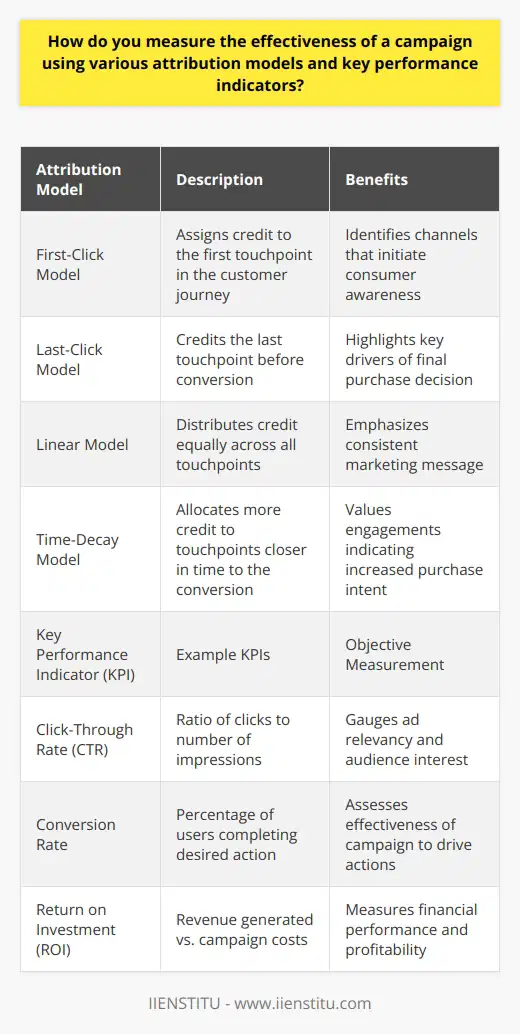
What tools are essential for accurately monitoring and assessing the performance of multiple marketing channels within a campaign, and how can these be leveraged for optimizing strategies?
Essential Tools for Monitoring Marketing Channels
Several tools are crucial for accurately tracking and assessing the performance of numerous marketing channels in a campaign.
Key Performance Indicators
Firstly, marketers need to employ key performance indicators (KPIs). KPIs help measure the effectiveness of various marketing techniques. They aid in determining which strategies yield the highest return on investment (ROI). By pin-pointing high-yielding strategies, marketers can optimize their efforts accordingly.
Marketing Dashboards
Secondly, marketing dashboards are required to provide a visual display of KPIs. Dashboards can display the results of different tactics and channels in real-time. These can help in making informed decisions for campaign revisions based on real-time performance data.
Analytics Tools
Thirdly, analytics tools such as Google Analytics, can help track and measure the effectiveness of the efforts. These tools can provide crucial data on user behavior, channel-performance, and conversion rates, helping precisely measure the ROI for individual marketing channels.
Performance Assessment Strategy
A comprehensive performance assessment strategy should include these tools. This strategy must enable data-oriented decision-making for future campaigns. Regular analysis is necessary to identify trends and patterns, and establish which approaches are most effective.
Usage of Tools for Optimization
These tools are crucial in optimizing marketing strategies. KPIs help indicate the efficacy of different strategies. Dashboards provide a real-time picture of their performance. Analytics tools give insights into user behavior and track successes.
Final takeaway
In conclusion, using KPIs, dashboards, and analytics tools are essential for accurately assessing marketing channel performance. Regularly updating these can result in detailed insights and help in developing effective, data-driven marketing strategies.

How can marketers combine social media analytics, predictive analytics, and sentiment analysis to assess the overall impact of their marketing campaigns on consumer behavior, brand image, and engagement?
Understanding Consumer Behavior through Social Media Analytics
In assessing the net impact of marketing campaigns, using social media analytics proves influential. Social media analytics provide marketers with critical insights into consumer preferences, habits, and sentiments, revealing how they interact with specific marketing content. This approach typically allows tracking consumer opinion and engagement levels over time.
The Relevance of Predictive Analytics in Campaign Assessment
Predictive analytics offer a forward-looking perspective. By forecasting future trends based on historical data, marketers can anticipate consumers' reactions to their campaigns, thus strategically tailoring them for maximum impact. This method allows marketing departments to develop their strategies more intelligently and to optimize their decision-making processes.
Sentiment Analysis Role in Evaluating Brand Image
Sentiment analysis further enriches the process by interpreting and classifying consumer emotions. This form of analysis allows identification of potential consumer responses to brand messages, indicating how brand image might subsequently be affected. Sentiment analysis gives marketers an immediate sense of public opinion to their campaigns, helping to optimize the brand image accordingly.
Engagement Assessment through Integrated Analytics
Combining these three analytics methods enables a comprehensive view of marketing campaign impacts. Social media and sentiment analysis yield granular insights into consumer responses, while predictive analytics points marketers towards potential future trends. Lastly, such analytics-driven insights help marketers intricately gauge and enhance their strategies, duly maximizing consumer engagement.
In conclusion, the integration of social media analytics, predictive analytics and sentiment analysis empowers marketers. It aids in assessing and predicting the overall influence of their marketing strategies on consumer behavior, brand image, and engagement.
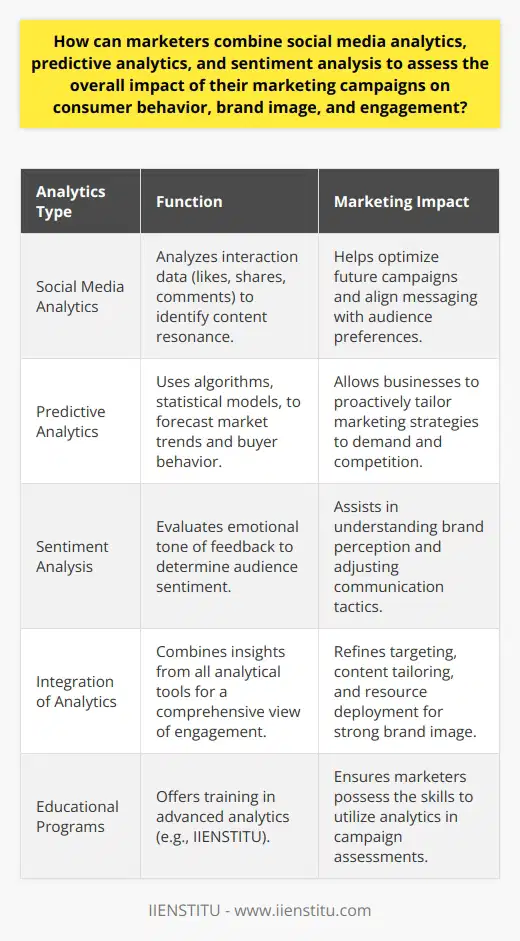
What tools are essential for accurately monitoring and assessing the performance of multiple marketing channels within a campaign, and how can these be leveraged for optimizing strategies?
Essential Tools for Monitoring and Assessing Marketing Performance
Marketing Performance Tools (MPTs) are key to accurately monitor and assess the performance of various marketing channels within a campaign. Examples include Google Analytics for website tracking, Hootsuite for social media management, and MailChimp for email marketing.
Effectiveness of Google Analytics
Google Analytics stands out for its ability to track website engagement and customer behavior, providing rich insights for data-driven decision-making. It can tell us where our traffic is coming from, the behavior of visitors on our site, and the interaction points that lead to conversions.
Role of Social Media Management Tools
Hootsuite plays a significant part in managing social media channels. It enables marketers to measure social media engagement, track post performance, and analyze audience demographics. Understanding these metrics can help in tailoring content to the target audience and improving engagement rates.
Email Marketing Evaluation Tools
Email marketing tools like MailChimp allow for monitoring open rates, click-through rates, and conversions from email campaigns. These metrics are critical in assessing the success of the campaign and informing content and design optimization.
Optimizing Strategies through Tools
Leveraging these tools effectively can help in optimizing marketing strategies. By having a clear understanding of channel performance, marketers can identify what works well, where improvements are needed, and strategize accordingly. For example, if Google Analytics shows low website engagement, one could revisit the website design or content strategy.
In conclusion, effective monitoring and assessing of marketing performance require specific tools. Google Analytics, Hootsuite, and MailChimp are instrumental in this process. They provide actionable metrics that can assist in optimizing marketing strategies for enhanced results.

How can marketers combine social media analytics, predictive analytics, and sentiment analysis to assess the overall impact of their marketing campaigns on consumer behavior, brand image, and engagement?
Utilizing Social Media Analytics
Initially, marketers can leverage social media analytics to track the performance of their campaigns. It monitors user engagement and the overall visibility of campaigns in real-time. These insights enable marketers to create content that resonates with their target audience.
Incorporation of Predictive Analytics
Next, predictive analytics can be used to anticipate future consumer behavior and trends. It uses historical data to predict possible outcomes. In marketing campaigns, predictive analytics can suggest the most effective strategies, leading to higher consumer engagement and enhancing the brand image.
Employment of Sentiment Analysis
Lastly, sentiment analysis is a much-needed tool for assessing consumer attitudes towards a particular campaign. It evaluates the emotions related to product reviews, comments, tweets, and more. Understanding these sentiments can help companies to adjust their strategies and communications to foster positive consumer perceptions and reinforce their brand image.
Overall Impact Assessment
By combining these analytical tools, marketers can thoroughly evaluate the effectiveness of their campaigns. Social media analytics provides the 'what', predicting analytics suggests the 'why', and sentiment analysis answers 'how' consumers feel about the campaign. Hence, marketers gain a more sophisticated, holistic, and reliable assessment of campaign impacts on consumer behavior, brand image, and engagement. This in-depth analysis enables them to develop finely-tuned, data-driven strategies that ultimately lead to improved outcomes in future campaigns. The strategic use of these analytical tools can revolutionize the effectiveness of marketing efforts, ensuring that businesses are communicating the right messages to the right audience at the right time.

In the realm of digital marketing analytics, what are some best practices for measuring return on investment (ROI) and attributing value to specific marketing efforts?
Selection of Appropriate KPIs
In observing ROI in digital marketing analytics, the strategic selection of Key Performance Indicators (KPIs) becomes essential. KPIs act as quantifiable measures to gauge the success of marketing endeavours. By identifying relevant KPIs like conversion rates, average order value, customer retention rates, and customer acquisition costs, marketers can effectively measure their ROI.
Use of ROI Calculation Formula
A basic ROI calculation formula can also be helpful for measuring returns on digital marketing investments. This formula calculates ROI by first deducting the initial investment cost from the net profit, then dividing that by the initial cost. The resulting figure indicates ROI as a percentage, clearly showing the effectiveness of the marketing efforts.
Employment of Attribution Models
For attributing value to specific marketing efforts, the use of attribution models can provide crucial insights. Models like Last Click, First Click, Linear, Time Decay and Position Based allow marketers to distribute credit for a sale or conversion across various touchpoints in a customer journey.
Implementation of A/B Testing
Lastly, implementing A/B testing can ensure the optimization of marketing efforts. Through comparing the performance of two variants of a campaign, this method makes it possible to identify which strategies yield the highest ROI, thereby driving future marketing decisions towards more profitable paths.
In conclusion, effective measurement of ROI in digital marketing analytics requires precise selection of KPIs, application of ROI calculation, utilization of attribution models for value attribution, and the consistent use of A/B testing for optimization.

